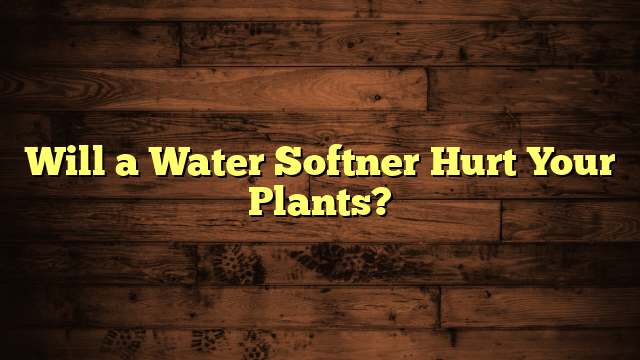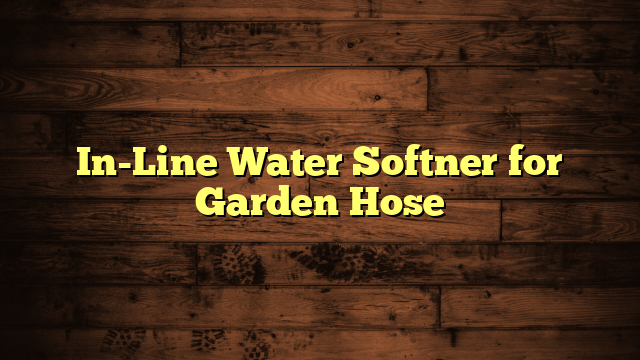Will a Water Softner Hurt Your Plants?
If you're using a water softener, you might be wondering whether it's affecting your plants. The high sodium content often introduced by these systems can disrupt nutrient absorption and alter soil health, leading to potential growth issues. It's essential to understand how this might impact your garden and what steps you can take to mitigate any negative effects. But before you make any decisions about your watering practices, consider the nuances of sodium's impact on different plant types and the soil they thrive in. What might be the best approach for your specific situation?
Key Takeaways
- Water softeners increase sodium levels in water, which can lead to sodium toxicity in plants, affecting growth and health.
- High sodium levels disrupt nutrient absorption, causing issues like reduced growth and leaf burn in plants.
- Sodium accumulation in soil can alter its composition, reducing permeability and making it harder for water and nutrients to reach roots.
- Regular testing of water quality is essential to monitor sodium levels and ensure optimal conditions for plant health.
- Using rainwater or filtration systems can provide safer water alternatives for irrigation, minimizing sodium exposure to plants.
Understanding Water Softeners
Water softeners play a crucial role in improving household water quality by removing minerals like calcium and magnesium that cause hardness. When you're considering a water softener for your home, it's essential to understand the different water softener types available.
You can choose from ion exchange systems, salt-free systems, or reverse osmosis units, each offering unique benefits. Ion exchange systems are the most common, effectively replacing hardness-causing minerals with sodium.
As you explore your options, installation considerations become vital. Determine where you'll install the unit, typically near your main water line, and make sure there's enough space for maintenance.
You'll also need to decide if you want a whole-house system or a point-of-use model, depending on your needs.
Keep in mind that some systems require regular salt refills, while others operate without salt. Your choice will impact not only your water quality but also your maintenance routine.
Impact of Sodium on Plants
When considering the impact of sodium on plants, it's essential to recognize that high sodium levels can lead to various issues. Sodium toxicity can disrupt plant absorption, making it difficult for your plants to take up essential nutrients and water. This can ultimately affect their growth and health.
Here are some key points to keep in mind:
- Reduced Growth: High sodium levels can stunt plant growth, leading to smaller, weaker plants.
- Leaf Burn: Sodium toxicity often manifests as leaf burn, where edges turn brown and crispy.
- Nutrient Imbalance: Excess sodium can interfere with the uptake of vital nutrients like potassium and calcium.
- Soil Structure: High sodium can negatively affect soil structure, leading to poor drainage and water retention.
- Increased Stress: Plants exposed to high sodium levels are more susceptible to stress from drought and disease.
If you've been using softened water, monitor your plants closely.
Addressing sodium levels promptly can help ensure your plants thrive instead of struggle.
Always remember that a balanced approach to watering is key to maintaining healthy growth.
Effects on Soil Health
High sodium levels not only affect plant health but also have significant implications for soil quality. When you use softened water, the sodium can accumulate in the soil, altering its composition. This accumulation disrupts the natural nutrient balance essential for plant growth.
As sodium displaces calcium and magnesium in the soil, it can lead to soil compaction and reduced permeability. This makes it harder for water and nutrients to reach plant roots, ultimately affecting their health. You might notice that your soil becomes less fertile over time, making it challenging to maintain a thriving garden or landscape.
Moreover, high sodium levels can lead to increased soil pH, which can further impede nutrient availability. Essential elements like iron and manganese may become less accessible, putting your plants at risk of deficiencies.
To maintain optimal soil health, it's crucial to monitor sodium levels carefully and consider alternative water sources, especially if you notice signs of soil degradation. By prioritizing soil composition and nutrient balance, you can ensure a healthier environment for your plants to thrive.
Identifying Salt-Tolerant Plants
Identifying salt-tolerant plants is essential for maintaining a vibrant garden, especially if you're using softened water that can raise sodium levels in the soil.
By choosing the right varieties, you can ensure your garden thrives despite the salt content. Start by looking for plants that naturally withstand salty conditions.
Here are some options to consider:
- Salt tolerant shrubs: Look into varieties like Bayberry, Beach Strawberry, or Sea Grape. These can add both beauty and resilience to your landscape.
- Salt tolerant grasses: Species like Fescue, Blue Grama, or Saltgrass are excellent choices for lawns or meadows.
- Herbs: Consider hardy herbs like Rosemary or Thyme that can tolerate saline conditions.
- Perennials: Plants like Sea Oats or Saltmarsh Mallow not only flourish in salty soil but also enhance biodiversity.
- Succulents: Many succulents, such as Ice Plant, are naturally adapted to salty environments and require minimal watering.
Best Practices for Watering
When watering your plants, it's crucial to consider the quality of the water you're using, especially if it's softened.
You'll want to pay attention to the timing and frequency of your watering to ensure optimal growth.
Additionally, using dilution techniques can help mitigate any potential negative effects of softened water on your plants.
Water Quality Considerations
Ensuring your plants thrive starts with understanding the quality of the water you use. The right water source can make a significant difference in your garden's health.
While municipal water is convenient, it may contain chemicals like chlorine and fluoride, which can harm your plants. If you're using well water, it's essential to test for contaminants, as high mineral levels can create issues.
Consider employing filtration methods to improve your water quality. Filtration systems can help remove impurities, ensuring your plants receive clean water.
Here are some best practices for selecting and using water:
- Test your water quality regularly to identify any issues.
- Use rainwater collected in barrels; it's often the best option for plants.
- Invest in a filtration system that suits your needs, like reverse osmosis.
- Avoid watering your plants with softened water, as it can contain excessive sodium.
- Always let tap water sit for 24 hours to allow chlorine to dissipate before use.
Timing and Frequency
Effective timing and frequency in watering are crucial for nurturing healthy plants. To maintain a strong watering schedule, you'll need to consider the specific needs of your plants and adjust based on the seasons. Consistency is key, but remember that factors like temperature and humidity can change how often you water.
Here's a simple guide to help you visualize the best practices for your watering schedule:
| Season | Watering Frequency | Notes |
|---|---|---|
| Spring | 1-2 times a week | Growth phase; keep soil moist. |
| Summer | 2-3 times a week | Hot weather; plants need more water. |
| Fall/Winter | 1 time a week | Dormant phase; reduce frequency. |
Dilution Techniques
How can you ensure your plants thrive while using softened water? One effective approach is to employ dilution methods. By mixing softened water with other sources, you can reduce the sodium concentration and provide a more balanced hydration for your plants.
Here are some best practices to consider:
- Rainwater collection: Capture rainwater in barrels and use it to water your plants. This natural resource is free of salts and ideal for your garden.
- Mix softened water with tap water: Combine softened water with unsoftened tap water to dilute the sodium content effectively.
- Use a water-to-soil ratio: Adjust your watering technique by ensuring the soil absorbs water properly. This helps distribute nutrients evenly.
- Monitor soil salinity: Regularly test your soil for salt levels, and make adjustments based on your plants' needs.
- Consider a bypass valve: If your water softener has this option, bypass it when watering your garden, ensuring your plants receive untreated water.
Alternatives to Water Softeners
Considering the impact of hard water on your plants, exploring alternatives to traditional water softeners can be beneficial.
One effective method is rainwater harvesting. Collecting rainwater not only reduces your water bill but also provides your plants with a natural, soft water source. You can set up barrels or tanks under your downspouts to capture rainwater, ensuring your plants get the best hydration without the adverse effects of hard minerals.
Another option is to use organic alternatives, such as vinegar or citric acid, to help soften your water naturally. A small amount of these substances can reduce mineral content, making the water more suitable for your plants.
Additionally, consider using reverse osmosis systems that filter out impurities without introducing harmful salts into your water supply. These systems can provide clean, soft water that's safe for both your plants and your home.
Making an Informed Decision
When deciding on the best water source for your plants, what factors should you consider?
It's essential to make an informed decision that aligns with your plant care goals and the specific needs of your garden. Here are some key points to think about:
- Soil Composition: Different plants thrive in various soil types; ensure you're familiar with your soil's characteristics.
- Plant Type: Understand the water needs of your specific plants, as some may prefer softer or harder water.
- Water Quality: Check for sodium levels in softened water, as high sodium can harm your plants over time.
- Irrigation Methods: Consider how you're watering your plants; some methods may dilute the effects of softened water.
- Long-term Effects: Think about the cumulative impact on your soil and plants over time, especially regarding nutrient balance.
Frequently Asked Questions
Can Soft Water Affect the Taste of Garden Vegetables?
Yes, soft water can affect the flavor of your garden vegetables. The sodium in soft water might alter their taste, leading to less vibrant flavors. You might want to consider using rainwater or untreated water for gardening.
How Does Water Hardness Impact Plant Nutrient Absorption?
Water hardness affects nutrient availability and soil pH. If you're using hard water, it can lead to nutrient lockout, making it harder for your plants to absorb essential minerals, ultimately impacting their growth and health.
Do All Plants React Similarly to Softened Water?
Not all plants react similarly to softened water. Some show greater plant sensitivity due to altered water composition, affecting nutrient uptake. It's essential to research specific plant needs before using softened water for irrigation.
Can I Mix Softened Water With Rainwater for Plants?
You can mix softened water with rainwater, balancing the softened water's sodium with rainwater benefits. This combination helps dilute potential negatives while providing essential nutrients, ensuring your plants thrive without adverse effects. Just monitor their response carefully!
What Are Signs of Sodium Toxicity in Plants?
You'll notice signs of sodium toxicity in plants through wilting, leaf burn, and stunted growth. High sodium levels can severely affect plant health, leading to nutrient imbalances and poor overall vitality. Keep an eye on your plants!
Conclusion
In conclusion, using a water softener can harm your plants due to the high sodium levels it introduces. This can disrupt nutrient absorption and negatively affect soil health. To protect your garden, consider diluting softened water with rainwater, choosing salt-tolerant plants, or exploring alternatives to water softeners. By staying informed and monitoring your plants' needs, you can maintain a thriving garden without compromising their health. Always prioritize your plants' wellbeing when making watering decisions.







